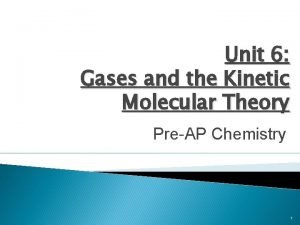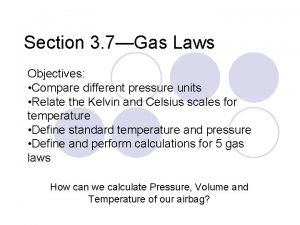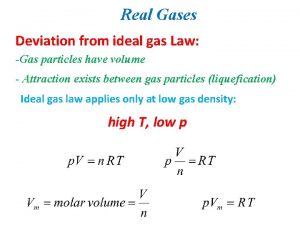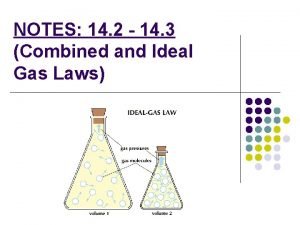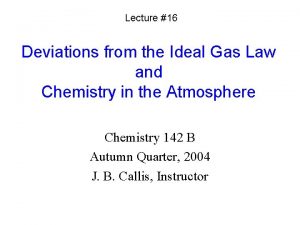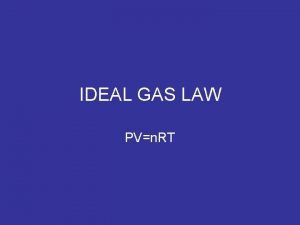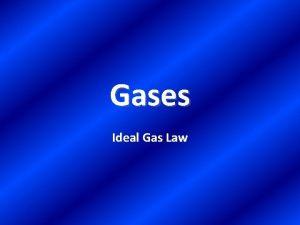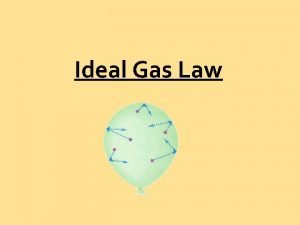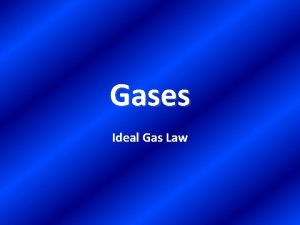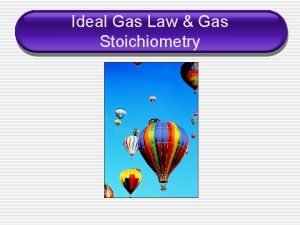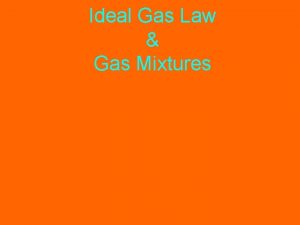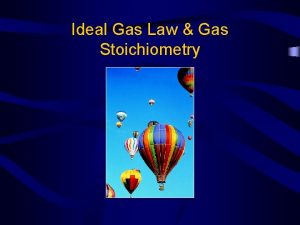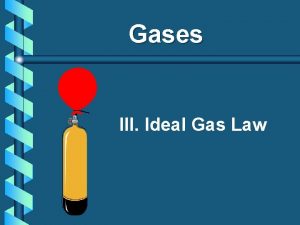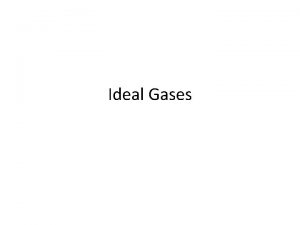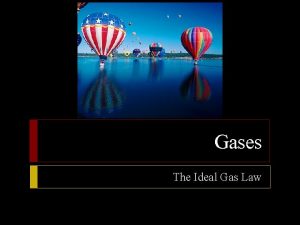Gases The Ideal Gas Law The Ideal Gas












- Slides: 12

Gases The Ideal Gas Law

The Ideal Gas Law Objectives State the ideal gas law Using the ideal gas law, calculate pressure, volume, temperature, or amount of gas when the other three quantities are known

The Ideal Gas Law Molar Volume of a Gas According to Avogadro’s law, V = kn (where n = number of moles of a gas), one mole of any gas will occupy the same volume as one mole of any other gas at the same conditions, despite mass differences STP is the standard temperature and pressure of a gas (273 K and 1 atm) The volume occupied by one mole of gas at STP is known as the standard molar volume of a gas, which is 24. 41410 L (rounded to 22. 4 L)

The Ideal Gas Law Molar Volume of a Gas Knowing the volume of a gas, you can use the conversion factor 1 mol/22. 4 L to find the moles (and therefore also mass) of a given volume of gas at STP 1 mol Example: at STP, 5. 00 L of gas x = 0. 223 mol of gas 22. 4 L You can also use the molar volume of a gas to find the volume, at STP, of a known number of moles or a known mass of gas 22. 4 L Example: at STP, 0. 768 mol of gas x = 17. 2 L of gas 1 mol

Gas Stoichiometry For gaseous reactants or products, the coefficients in chemical equations not only indicate molar amounts and mole ratios but also reveal volume ratios, assuming conditions remain the same. Example: 2 CO + O 2 → 2 volumes 1 volume 2 CO 2 2 volumes

The Ideal Gas Law You have learned about equations describing the relationships between two or three of the four variables— pressure, volume, temperature, and moles—needed to describe a gas sample at a time All of the gas laws you have learned thus far can be combined into a single equation, the ideal gas law: the mathematical relationship among pressure, volume, temperature, and number of moles of a gas

The Ideal Gas Law It is stated as shown below, where R is a constant: PV = n. RT P = pressure V = volume n = number of moles of gas T = temperature R = constant

The Ideal Gas Law Constant In the equation representing the ideal gas law, the constant R is known as the ideal gas constant Its value depends on the units chosen for pressure, volume, and temperature in the rest of the equation Measured values of P, V, T, and n for a gas at near-ideal conditions can be used to calculate R:

The Ideal Gas Law Constant The calculated value of R is usually rounded to 0. 0821 (L • atm)/(mol • K) Use this value in ideal gas law calculations when the volume is in liters, the pressure is in atmospheres, and the temperature is in kelvins The ideal gas law can be applied to determine the existing conditions of a gas sample when three of the four values, P, V, T, and n, are known Be sure to match the units of the known quantities and the units of R

The Ideal Gas Law Numerical Values of the Ideal Gas Law Constant

The Gas Laws The Ideal Gas Law Sample Problem What is the pressure in atmospheres exerted by a 0. 500 mol sample of nitrogen gas in a 10. 0 L container at 298 K?

The Gas Laws The Ideal Gas Law Sample Problem Solution Given: V of N 2 = 10. 0 L n of N 2 = 0. 500 mol T of N 2 = 298 K Unknown: P of N 2 in atm
 Pseudo reduced specific volume
Pseudo reduced specific volume An ideal gas is an imaginary gas
An ideal gas is an imaginary gas Gas law
Gas law Sutherland's law
Sutherland's law Difference between ideal gas and real gas
Difference between ideal gas and real gas Ideal gas law with mass
Ideal gas law with mass Gas laws formulas
Gas laws formulas Units of pressure
Units of pressure Which equation agrees with the ideal gas law?
Which equation agrees with the ideal gas law? Deviation from ideal gas
Deviation from ideal gas Pv nrt
Pv nrt Deviations from ideal gas law
Deviations from ideal gas law Ideal gas law graphs
Ideal gas law graphs





